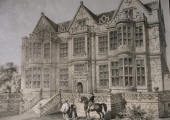.
The Hall
Holt Road, Bradford on Avon, Wiltshire
.

The west front of The Hall, from Conigre Hill
.
The Hall, situated on the eastern outskirts of the town, is one of the most important of Bradford on Avon’s buildings and grade I listed.
A house existed here in the mid-13th century and the family who owned it took their name of Hall from it. John Leland, who was reporting on the state of the nation for King Henry VIII, in about 1540 described it as “a pratie stone house at the este end of the towne”. It would originally have been a hall, to which, by Leland’s time, more comfortable wings had been added, like Great Chalfield, Westwood and South Wraxall manor houses.
 At the end of the 16th century, or just into the next, the Halls rebuilt it into an Elizabethan mansion, with a fancy renaissance south front in the style of Longleat or Hardwick Hall. From investigations carried out recently, it appears that some of the walls of the old medieval hall-house still survive in part of the later house.
At the end of the 16th century, or just into the next, the Halls rebuilt it into an Elizabethan mansion, with a fancy renaissance south front in the style of Longleat or Hardwick Hall. From investigations carried out recently, it appears that some of the walls of the old medieval hall-house still survive in part of the later house.
.

 Two of the fireplaces in the Hall. In the panels above are arms of the Hall family, including their own of three poleaxes on a black background.
Two of the fireplaces in the Hall. In the panels above are arms of the Hall family, including their own of three poleaxes on a black background.
.
.
 The Hall family estate covered much of the land on the eastern side of town and in Holt, with pieces in Trowbridge and Freshford as well. Thomas Halle (died 1457) was patron of the church of Freshford in 1444 and MP for Bath. After the dissolution of Bath Abbey in the 16th century, a Hall was able to purchase much of the monastic buildings and land in the town, between the church and the river to the south.
The Hall family estate covered much of the land on the eastern side of town and in Holt, with pieces in Trowbridge and Freshford as well. Thomas Halle (died 1457) was patron of the church of Freshford in 1444 and MP for Bath. After the dissolution of Bath Abbey in the 16th century, a Hall was able to purchase much of the monastic buildings and land in the town, between the church and the river to the south.
.
The house called Ivythorpe (above- c1720 front, but older behind), opposite Freshford church, has the Hall arms above its door.
 In 1700 John Hall set up a charity to provide the almshouses for poor men in Frome Road that bear his name and a fund to pay £40 a year for their upkeep. At the centre of the building are the arms of the Halls -three silver poleaxes on a black background- and the words Deo et pauperibus, “for God and the poor”.
In 1700 John Hall set up a charity to provide the almshouses for poor men in Frome Road that bear his name and a fund to pay £40 a year for their upkeep. At the centre of the building are the arms of the Halls -three silver poleaxes on a black background- and the words Deo et pauperibus, “for God and the poor”.
.
.
The Hall line of Bradford died out with the death of John Hall in 1711 and the estate passed to Rachel Baynton, who may have been his illegitimate daughter. She married William Pierrepont, who became the first Duke of Kingston. When Evelyn, the 2nd Duke, died in 1773 the estate passed to his nephew Charles Medows, who became Viscount Newark in 1796 and Earl Manvers in 1806. This explains the names Newark Street, Pierrepont Street, Manvers Street, Kingston Road and Kingston Buildings of the former Hall estate in Bath.
 The Hall became known as The Duke’s House (the title of this print by Charles Richardson), or more frequently as Kingston House. A big new woollen cloth factory, known as Kingston Mill, was built in front of it by industrialist Thomas Divett at the beginning of the 19th century. Meanwhile the house was let to various people, including Samuel Pitman, father of Isaac and became neglected. In 1848 Stephen Moulton bought the Bradford estate and factories and restored the house to its former glory.
The Hall became known as The Duke’s House (the title of this print by Charles Richardson), or more frequently as Kingston House. A big new woollen cloth factory, known as Kingston Mill, was built in front of it by industrialist Thomas Divett at the beginning of the 19th century. Meanwhile the house was let to various people, including Samuel Pitman, father of Isaac and became neglected. In 1848 Stephen Moulton bought the Bradford estate and factories and restored the house to its former glory.
.

